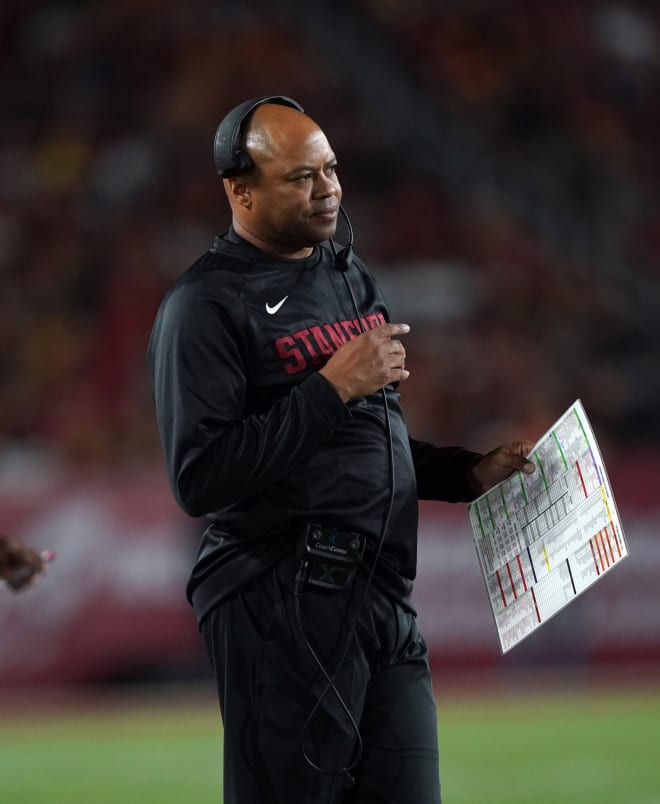Stanford has problems at the LOS, so what are the solutions?

Stanford is a flawed football team. Welcome to the club where you'll find most of college football is a member; and the challenge they and the Cardinal face every week is how to overcome weaknesses -- potentially major ones -- to win.
The final score in The Coliseum read 45-20 and it wasn't that close by the end. USC outscored Stanford 42-3 in a stunning onslaught powered by a near perfect game from a freshman quarterback and a shutout in the second half by the Trojans defense. By the time a relieved Clay Helton (he found his savior) shook hands with a stone-faced David Shaw the Cardinal's 17-3 lead in the second quarter felt like it happened in another game.
The play on the field exposed a number of problems for Stanford that Cardinal Sport Report will take a shot at addressing them.
A Rickety OL Is Getting Shakier, Younger
Stanford finished the game at USC with two freshmen on the line: Walter Rouse at left tackle and Barrett Miller at right tackle.
All-American left tackle Walker Little will miss the rest of the season because of the knee injury he suffered in the season opener. Then Foster Sarell got hurt late in the USC game and Miller had to take over for six plays.
Rouse started at left tackle in place of Little, but he might not have if backup guard Dylan Powell was available to play so that Devery Hamilton could move to tackle. Powell is out for an unknown amount of time and did not dress for practice Tuesday.
The injuries to the short list of experienced linemen on the team leaves only freshmen available to step up. In fact, Stanford's depth chart lists only three non-freshmen linemen: Drew Dalman, Hamilton and Henry Hattis, who is No. 1 at both right tackle and right guard until the staff decides who among the freshmen will start.
There's really only one way to give a team a good chance to score a lot of points with an offensive line suffering that much turmoil: Hurry up.
Stanford actually has put together several time-consuming drives in the first two games of the season and ended one 15-play, 90-yard beauty with a touchdown against Northwestern. Stanford has also come off the field without points after mistakes sunk several long drives.
The odds of Stanford consistently manufacturing methodical drives -- during which the play clock is routinely under 10 seconds before the snap -- with this reconfigured offensive line seems unlikely. Instead, Shaw and the Cardinal need to limit substitutions, keep the same defenders on the field, and don't give opposing pass rushers enough time to size up a shaky line.
The transition to a quicker passing game led by an fourth-year quarterback should be tailor made to speed up the tempo. It's also a style Costello prefers anyway. Stanford has a mismatch machine in Colby Parkinson who should always be on the field and can be moved around the field to fit a number of roles on a drive.
Costello touched on how this approach can help when asked after practice Tuesday about helping a reconfigured line be successful.
"First thing that jumps to mind is when I watch the defense, when we go down the field four, five, six, seven plays of a drive the pass rush is depleted. A lot of things are depleted in terms of taking onus off of the offensive line. We have to get drives going. We have to get three to seven snaps into that drive to slow the pass rush down. We have to get the ball out early, pick up first downs, run the ball effectively, get that first first down. We have to get deep into drives and find rhythms. I can help them out by getting the ball out quick, diagnosing the defense and get the ball in our playmakers. I thought in the first game we did a great job and in the second game pretty good, too."
Pass Rush Is Missing In Action
All offseason Shaw was uncharacteristically blunt by his standards when talking about the need for the defensive line to step up from last season.
Watching the USC game again it was a replay of many games last season when Stanford's defensive front -- base or nickel, but especially nickel -- not only couldn't hold up at the line of scrimmage, but was pushed back.
Kedon Slovis completed 28-of-33 passes (84.8 percent!) for three touchdowns, no interceptions and was sacked once on third down on the first drive of the second half. Shaw squashed any thought that USC"s "air raid" offense got the ball out too quickly for pass rushers to reach Slovis.
“It didn’t have to do with the air raid or anything, it has to do with us rushing the passer. Style of offense didn’t matter because the ball wasn’t coming out that quick. He was still able to go back and go through his reads. We’ve just got to beat guys one-on-one. We got to him a couple times, but not enough.”
Stanford won't have many opportunities to use its base defense in the coming weeks, so a solution has to be found to get pressure with two defensive linemen on the field. In the second half Anderson started calling blitzes by his defensive backs with minimal effect, but it's an example of the type of outside-the-box thinking he will need to employ.
Stanford also may need to give some new faces a chance. It could be an interesting week of practice as Shaw is sure to follow up on his words from last season that if a defensive lineman can't get to the quarterback they'll rotate until they find one who can.